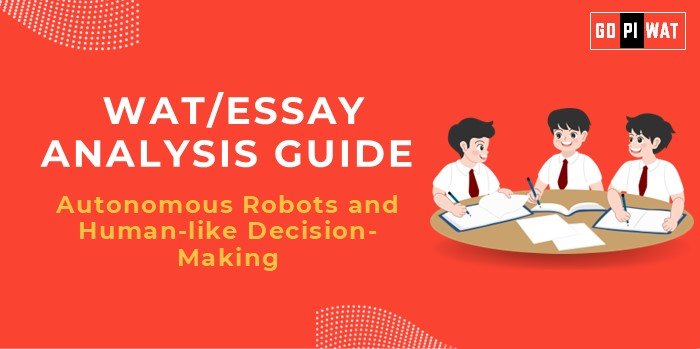📋 Written Ability Test (WAT) / Essay Analysis Guide
🌐 Understanding the Importance of Trust in Autonomous Robots
Trust in autonomous robots with human-like decision-making is crucial due to their increasing integration into high-stakes fields, such as healthcare, law enforcement, and transportation. Ethical transparency, accountability, and reliability are central concerns, making this a pressing issue for future leaders in technology and business.
📊 Effective Planning and Writing
- ⏱️ Time Allocation:
- 📝 5 minutes: Analyzing the topic and outlining main points.
- ⌨️ 20 minutes: Writing the essay, emphasizing achievements, challenges, and future considerations.
- 🔍 5 minutes: Reviewing for coherence and accuracy.
- 📋 Structure:
- Introduction: ~60-70 words, offering an engaging opening.
- Body: ~350-375 words with achievements, challenges, and future perspectives.
- Conclusion: ~60-70 words, providing a balanced or future-focused closure.
✨ Introduction Techniques
- Contrast Introduction: “While autonomous robots offer efficiency, entrusting them with human-like decision-making challenges ethical boundaries and societal trust, especially when high-stakes decisions are involved.”
- Future Vision Introduction: “As robots are entrusted with complex decision-making, society faces a critical choice: to foster trust through transparency or maintain limitations to protect human values.”
🔍 Structuring the Essay Body
The body of the essay should effectively explore achievements, challenges, and future perspectives related to autonomous robots. Key sections to include:
- Achievements: Highlight the successes of autonomous robots, such as reduced human error in automated vehicles, advancements in surgical precision, and increased efficiency in sectors like manufacturing.
- Challenges with Comparative Analysis: Address issues like accountability in ethical AI, citing examples such as Japan’s successful integration of robots in elderly care contrasted with privacy and regulatory concerns in the West.
- Future Outlook: Suggest a cautious approach to increased autonomy, highlighting the importance of regulations, ethical frameworks, and maintaining human oversight to build public trust.
📄 Concluding Effectively
- Balanced Conclusion: “While autonomous robots excel in specific domains, complete trust in their human-like decision-making capacities requires thoughtful regulations, transparency, and ethical oversight.”
- Global Perspective Conclusion: “Globally, trust in robots varies, reflecting each culture’s unique perspective on technology’s role in society. A universally agreed-upon framework could ensure that these machines serve society responsibly.”
📊 Analyzing Successes and Shortcomings
- Achievements: High precision in controlled environments, notable in autonomous medical systems and vehicles; success in manufacturing and repetitive tasks.
- Challenges: Ethical limitations, gaps in human-like judgment capabilities, and cybersecurity risks.
- Global Context: Japan’s positive integration of robots in social care contrasted with more cautious approaches in the U.S., where strong regulatory frameworks remain in place for safety.
💡 Recommendations for Sustainable Progress
- Transparent Ethical Policies: Companies should be required to disclose decision-making frameworks of autonomous robots to build public trust.
- Human Oversight in High-Stakes Decisions: Mandate human involvement in decisions where robots may lack ethical discernment, especially in healthcare and law enforcement.
- Strengthen Cybersecurity Measures: Protect autonomous systems from potential breaches to safeguard both public trust and individual privacy.
📚 Sample Short Essays
- Balanced Perspective: “Autonomous robots are transforming industries, but the question of whether to trust them in decision-making roles remains complex. Building a reliable framework that includes human oversight and transparency is essential for a balanced path forward.”
- Solution-Oriented Approach: “While robots continue to reshape sectors like healthcare and transport, balancing their autonomy with clear ethical guidelines and human supervision will foster the public trust necessary for wider adoption.”
- Global Comparison: “Japan’s integration of robots in elderly care highlights potential societal benefits, yet other nations, particularly in the West, remain cautious. This difference underscores the need for globally consistent, yet culturally sensitive, ethical frameworks for AI and autonomous technology.”
🎓 Additional Insights for B-School Students
- Understanding Ethical AI and Regulation: B-school students preparing for careers in tech, healthcare, or public policy should prioritize knowledge in AI ethics and compliance, as these areas are rapidly evolving.
- Research Opportunities: Projects on building ethical frameworks, analyzing public trust metrics, and studying AI’s regulatory landscape would provide valuable insights for real-world applications.
- Internship Potential: Internships in companies leading AI ethics and compliance, such as Google, Microsoft, or regulatory bodies, can give students a competitive edge in understanding the balance between innovation and responsibility.


